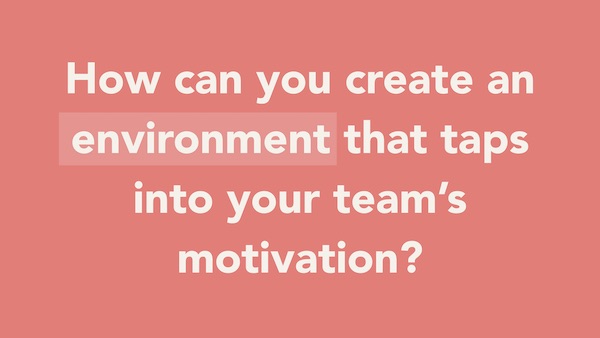Here are 7 practices focused on creating the right environment for motivating employees to go above and beyond.

Imagine the best team you’ve ever been a part of: One where a leader is motivating employees to go above and beyond to achieve a shared purpose. Everyone is contributing their best work and elevates the outcome to be far greater than what was even originally envisioned.
Does it sound like wishful thinking?
I don’t blame your skepticism.
Trying to figure out how to motivate our team to go above and beyond may feel like a naive quest for an illusionary Holy Grail – especially when maintaining a baseline of motivation can feel like a struggle with our own teams. After all, according to Gallup, only 2 in 10 employees strongly agree that their performance is managed in a way that motivates them to do outstanding work, in the first place.
Motivating employees to go above and beyond must require secret alchemy of high salaries plus unthinkably posh perks plus some trendy goals framework attached to it… Right?
Wrong. Motivating employees to go above and beyond is not an elusive myth, beholden to only the teams that get lucky or can afford to buy their team’s motivation.
Rather, motivating a team to go above and beyond requires a rigorous reexamination of what truly motivates a team, and how to connect that motivation to the greater vision of what you’re pursuing.
Ready to unlearn, and then re-learn? Let’s jump in…
Demystifying employee motivation
In order to motivate employees to go above and beyond, we must first start with the question: What is motivation, to begin with?
The simplest definition can be reduced to “motivation is wanting,” as defined by Roy Baumeister in 2016. The wanting to achieve great work, the wanting to go above and beyond, the wanting to produce a high-quality outcome… These are “wantings” that we aspire our team to intrinsically have. And in the context of the team these wantings – motivation – are immensely powerful.
To increase and direct our team’s wantings, as leaders, we create and leverage what tools and systems we have: Goals and monetary incentives, most commonly. Perhaps it’s using the OKRs goals framework, or awarding bonuses when certain milestones are hit, or giving generous healthcare benefits.
While these goals and incentives are helpful, they also overly employ extrinsic motivation. That is, they rely on an external factor to conjure a compelled sense that someone should do something.
Extrinsic motivation can absolutely work for motivating employees to go above and beyond, especially in the short term. However, studies have shown that if you want results to truly be long-lasting, for employees to be motivated to go above and beyond, we must tap into intrinsic motivation.
A 2011 study, in particular, revealed how employees who are intrinsically motivated are three times more engaged than employees who are extrinsically motivated. COVID-19 further exposed this reality for many of us: With the ability for people to work remotely, people’s desire for roles more aligned with what they personally want for themselves and their lifestyle – intrinsic motivation, in short – has resulted in the “Great Resignation.” Extrinsic motivation is not enough.
Intrinsic motivation is what we as leaders are truly looking to tap into if we want our employees to go above and beyond. The kind of motivation that is self-generated, from the employee themselves, around what they want for themselves that contributes to what the team is trying to accomplish.
This requires a reframing of employee motivation for us as leaders, as a whole. We cannot merely ask: “How do I motivate my team?” because doing implies that motivation is a thing we give to our team. But in fact, our team is already motivated intrinsically – they already have beliefs, willingness, ideas, talents, and gifts inside them. Rather, if we want to increase intrinsic motivation in our team, we must ask: “How do I create an environment that enables my team to motivate themselves?”


An environment is what we influence as leaders – not people, themselves.
This difference is beyond semantic. When we focus on influencing the environment versus influencing people, we unlock the real secret to enabling motivation: That motivation is not a dial you can crank up nor a series of checkboxes you tick. It is a true commitment to first understanding what motivates your team – and then connecting what motivates them to what you’d like the team to accomplish. Only in this reframing are you able to be motivating employees to go above and beyond.
So, how do we do it? How do we create an environment for our team to tap into their own sense of intrinsic motivation?
Let’s dive into the 7 practices for motivating employees to go above and beyond…
7 practices for creating an environment for your team to motivate themselves
# 1: Define the observable behavior.
What do we want, as leaders? Yes, we want to be motivating our team to go above and beyond… but above and beyond what? What does “higher motivation” exactly mean?
Oftentimes, when we say “I need to motivate more our team,” we’re wildly imprecise in identifying the real output of strong motivation. Does it mean your team is moving faster? Does it mean a higher quality of work? There’s a large gap between what I call the “desired descriptor” and the “observable behavior.”
A desired descriptor is a vague generalization. An observable behavior is a specific, tangible action or event that we could point to, so we can anchor future action around it.
For instance, you might say, “I want more engagement,” but what you really mean is, “I want more participation in the learning opportunities we give our staff.” The former is the desired descriptor – a fuzzy notion of an idea. The latter is an observable behavior – a firm, noticeable event we’d like to see happen.
Here’s another example: You might say, “I want better performance,” but what you really mean is “I want our team to have a higher bar for the quality of work.” The former, as a desired descriptor, doesn’t give you much basis for action. The latter precisely identifies an observable behavior you’d like to pursue.

See the difference?
This distinction between the desired descriptor and observable behavior is critical because if we’re unable to zero in on exactly what we want to change, then we have no hope of changing it.
#2: Play detective.
You know what you want… But what does your team want?
Yes, you’ve identified the observable behavior you’d like to see being exhibited by your team. But how does your team feel about it? What is your team motivated by?
To uncover what your team exactly wants, here are some questions you can ask your team members during a 1:1 meeting around motivation:
- What project or part of your job do you feel most energized or excited about working on? Why?
- What project or part of your job do you feel most in your “flow state”? Why?
- Which project do you most look forward to working on? Why?
- When have felt most proud to have been a part of the organization? Why?
- In your work life, what would you feel most deeply motivates you or feels most rewarding?
These questions can give you a sense of what your team wants – and so you can better align that wanting with the observable behavior you’d like to see different.
Eager for more of these questions around motivation? Be sure to check out our training program, which includes an entire module on how to run effective 1:1 meetings and gives you templates and questions to choose from.
#3: Individualize everything.
Motivation is personal. What motivates your newest hire might not be what motivates someone who’s been on your team for a long time. Everyone’s source of motivation is different.
While this truth feels obvious, we often unintentionally as leaders project our own preferences, ideas, and sources of motivation onto others. Recently, I was speaking with a leader who was confused about why a team member was struggling. “I love projects like this,” this leader told me. It wasn’t until after we examined the scenario together did this executive realize this team member was struggling with work because the team member disliked ambiguity – and she as a leader loved ambiguity.
Feel familiar? No worries, it happens to the best of us. As a result, we must align projects, goals, communication, and incentives with what the other person is motivated by, if motivating employees to go above and beyond is our intention.
Here are some examples of how you can do this…
- If a direct report is motivated by public recognition, give public recognition to a direct report when a project is complete.
- If a direct report is motivated by detailed work, switch your direct report to be focused on more detail-oriented initiatives, instead of creative projects.
- If a direct report is motivated by having deep thinking time, move or cancel a video chat meeting so a direct report has more uninterrupted time to work.
Whew. If this sounds like a lot of work…it’s because it is 🙂 Individualization requires effort and time to do, especially the more direct reports you have.
However, individualization is a core tenet of practicing great leadership. Creating the best environment for our team relies on our ability to create the best environment for each specific person. There are no shortcuts.

Admittedly, you may not be able to individualize all the time. Sometimes there are projects that have to get done – and you can’t customize or individualize them. What do you do in those situations? Read on.
#4: Stop surveillance. Give choice.
While you can’t always perfectly individualize and align someone’s project and goals with what they are most motivated by, you can create positive conditions for motivation by giving choice in what people can do. In Edward Deci’s formative book on human motivation theory, Why We Do What We Do, he describes how “meaningful choice engenders willingness” and results in a higher quality of decisions, and greater motivation and commitment to the task, shown from research he’s done over 20 years.
Here are some scenarios for how you can give choice in situations even when it feels like there might not be much choice, to begin with…
- Instead of dictating the approach to a project, give options to an employee for how they’d like to approach the project and which tools they’d like to use.
- Instead of imposing when the exact deadline should be for a project, give choice by asking, “What deadline do you think makes the most sense, given the context of this project?”
- Instead of assigning a direct report a set of goals, invite them to participate in the formation of those goals so they have a choice in goals set.
Even further, as described by Deci, studies have revealed that when people can actively choose their own goals, they’re more likely to follow through on them. And so, choice is critical in creating an environment for motivating employees to go above and beyond.
#5: Highlight progress – efficiently and meaningfully.
What makes for a “great day at work”?
A landmark study shared by Harvard Business Review in 2010 sought to answer this question, in which they examined the diary entries of nearly 12,000 workers. From this, they found that making progress in one’s work (even incremental!) is more frequently associated with positive emotions and high motivation more than any other workday event.
Not getting a raise. Not getting a compliment from their boss. Making progress is what made for “a great day at work.”
Consider for yourself the same question: What makes for a “great day at work” for you? When you talk to your partner or a friend at the end of the workday and they ask you “How was work today?” what influences your response to them the most?
Like the 12,000 workers studied, you might find a similar sense of “a great day” equating to making progress at work. The days we get stuck, where had meetings all day and got nothing done, or aren’t sure why or how our work is helping us move forward, is massively demotivating. And the days where we make progress feel exemplary.
As a result, as leaders, we must be vigilant about proactively sharing progress as much as possible for motivating employees to go above and beyond.

Here are two high-leverage ways to do this:
Automatic status updates: Rather than asking your team to write up a lengthy progress report every week or attend lengthy status update meetings, keep your day-to-day status updates efficient and consistent. Specifically, consider automating your progress updates as much as possible. Here at Know Your Team, we use our own Heartbeat Check-in every single day as a way to proactively share progress. Every day, each person shares what they worked on yesterday and what they’re going to work on today – and it gives an easy way for everyone to have a high-level view of what progress we’re making as a team, while saving us time and effort in the process.
Meaningful “big picture” write-up of progress: To help your team understand how their day-to-day progress fits into the greater progress of the team, you’ll want to spend some time each week or each month (or both) writing up how the team as a whole is making progress. Here at Know Your Team, I do this by writing a brief update to the team every Monday that answers: “How are we tracking toward our big picture goals and priorities this month?” And every month, I write up an in-depth summary of “How did we do last month, and what are we looking toward for next month?” Both big picture write-ups highlight progress on a more macro level and give greater coherence to the work each of us is doing on a day-to-day basis.
Progress is an engine for motivation. But it begs the question: What is your team making progress towards? Keep reading for the answer…
#6: Go big on a “picture of a better place.”
We’ve discussed how to create conditions for your team to feel motivated… But what is it that we want our team to feel motivated about? There must be some ultimate outcome, some culminating end state that is compelling and animating your team to feel excited in the first place, and motivating employees to go above and beyond.
That would be vision: A picture of a better place. A picture of what the future world looks like because of the work you do. The clearer the vision is, the clearer that your team understands what their work adds up to and what they’re building towards.
The question is: How clear have you been illustrating this vision? I recently spoke with a CEO who admitted that though their mission and values were very clear, their vision was blurry. “I’ve been talking a lot about the work we do,” shared this CEO, “but not illustrating the end state, the better world we create, because of it.”
For instance, here are Know Your Team, our mission is to help leaders become better. But that’s not our vision – because “helping leaders become better” doesn’t describe a future world or end outcome. Rather, our vision is “a world where bad bosses are the exception and not the norm.”
Our mission describes what we do today. Our vision describes what we’d like the world to look like because of what we do, in the future.
Consider the company Apple as another example. Their mission, one might say, is “to create products that make people’s lives easier and more enjoyable.” But their vision – the picture of a better place – is “a world where more meaningful connection and work happens, delightfully, and simply.”
Notice the difference? The more we as leaders can illustrate vision, rather than just mission, the more that we can create an environment that motivates employees to go above and beyond.
#7: Clarify expectations. (It’s never too clear.)
We all recognize the importance of setting clear expectations as leaders. And yet, according to a 2017 survey by Gallup, only 50% of employees clearly know what is expected of them at work. Furthermore, only 26% of employees strongly agree that their manager continually helps them clarify priorities.
A gap exists. As leaders, we have strong expectations for what the work should look like – but we don’t always communicate that up front. We must bridge this gap, as an employee can’t tap into their own sense of motivation if they don’t know what they should be doing in the first place.
Ask yourself: How can you make expectations for great work even clearer?
Specifically, you can ask your team members directly in one-on-one meetings:
- Is it clear what projects are most important?
- Is it clear why the project matters?
- Is it clear why the level of urgency around the project exists?
- Is it clear what “success” for this project looks like?
- Is it clear what external factors the team should consider in order to successfully execute this project?
You can signup for our training program which includes an entire modules and a guide on one-on-one meetings and gives you questions and templates to try.
I hope these 7 practices provide a useful starting point, as you consider motivating employees to go above and beyond. Keep in mind: These are practices. They require repeated implementation and enacting to get us closer to where we want to be. Motivation won’t just “appear” overnight. Rather, it’s the outcomes of these repeated actions that focus on creating the right environment, rather than trying to manipulate people.
Begin with one of these practices today, and you’ll be on your way to creating an environment for motivating employees to go above and beyond.
If you’re looking to put these practices to use, you’ll want to try Know Your Team – our training program offers on-demand guidance, templates and more many topics to help you create an environment that enables team motivation remotely in a sustainable way. Try Know Your Team for free today.



